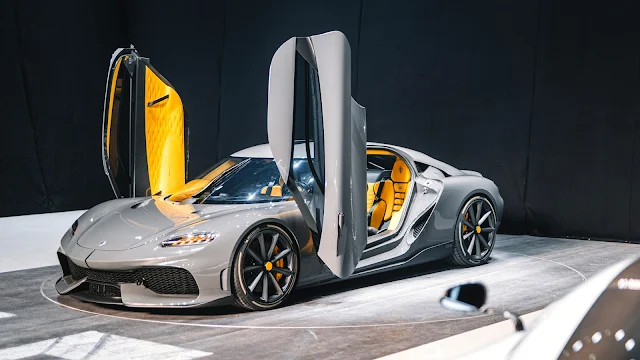Koenigsegg Gemera
 |
| image is taken from topgear.com |
Koenigsegg Gemera: OVERVIEW
Trust Christian von Koenigsegg to do something insane, like hosting a press conference in the halls of the now-canceled Geneva International Motor Show. But when Koenigsegg does something outrageous, they go big; or in the case of the new Koenigsegg Gemera they go 'mega'.
While Koenigsegg has previously only developed two-seater hypercars, the Gemera is the first of a new breed, the first Koenigsegg built to be enjoyed by four occupants. It's not a hypercar, it's a 'Mega GT car, and it's changing the high-performance game before it's even a week old.
The Gemera, whose name is taken from the Swedish phrase "to offer more," not only has four seats, but it does so with 1,727 horsepower and a mind-blowing 2,581 lb-ft of torque. The Koenigsegg Gemera is said to be capable of reaching speeds of more than 240 mph and sprinting from 0 to 62 mph in less than two seconds thanks to a mid-mounted three-cylinder engine and three batteries.
The Swedish hypercar manufacturer is once again inventing where others remain with the known and true; it's a wild new world.
Koenigsegg Design Innovation in Every Factor
Koenigsegg makes sure that every vehicle they build has a distinctive character that makes the car instantly recognizable, in contrast to many manufacturers who hire the talents of well-known design studios to pen the designs of their vehicles.
We're not referring to the Ghost Squadron logo used on vehicles produced in the company's Angelholm manufacture and development center; rather, we're referring to a design aesthetic that was first used on Christian von Koenigsegg's very first prototypes.
To do this, the Gemera has a wide front fascia with protruding intake ducts and thin LED headlamps. The massive carbon fiber wheels and side ducts that direct a lot of air to the mid-mounted engine, as well as other cooling systems required to maintain a 1,700+ horsepower hybrid at ideal operating temperatures, dominate the side profile.
A pair of Akrapovic top-exit exhausts produce a distinctive sound, while an integrated spoiler and noticeable diffuser help the vehicle's rear end achieve the slick aerodynamics required to travel at 248 mph.
The KATSAD door design, however, is unquestionably the Gemera's jewel in the crown. The now-iconic Koenigsegg Automated Twisted Synchro helix Actuation Doors, or KATSADs for short, have been modified for use on a four-seater with enormous doors that open up the entire side profile of the car, allowing entry and exit for both front and rear passengers without the need to move the seats at all.
With space for four people, the huge GT's carbon fiber body is an example of Koenigsegg's inventiveness.
The practicality of family at 249mph
Koenigsegg has never before given seating for more than two people, thus the interior of the Gemera is a completely novel experience for the brand. But Koenigsegg makes the audacious claim that four people of 6'5" can comfortably fit, without the need to change the position of the front seats, in contrast to other GT cars that offer 2+2 seating where the back seats are reserved primarily for double-leg amputees.
It's an amazing feat, and what's even more amazing is that entry and exit are made simple by the car's unusual doors, which open up the entire side of the vehicle.
Once inside, the inside features the best materials in a custom-tailored design, with typical Koenigsegg elegance and attention to detail; carbon fiber is the material of choice, though. Four heated and four cooled cupholders are distributed throughout the interior, which also has tri-zone automatic climate control, wireless phone chargers in the front and back, and entertainment screens in both the front and back.
Memory foam seats with heated features and power adjustments come standard, and the infotainment system includes an 11-speaker sound system and complete Apple CarPlay connectivity.
It is absolutely bespoke, truly luxurious, and has four seats, all without sacrificing the Koenigsegg DNA to which we have grown accustomed. Two trunks provide further attention to detail; the rear trunk can fit three carry-on suitcases, while the front trunk can fit just one, guaranteeing that all four passengers may bring luggage along for the voyage.
Performance Of The Tiny Friendly giant
An innovative 2.0-liter twin-turbo three-cylinder engine, dubbed the Tiny Friendly Giant (TFG), powers the Gemera. Drive is transmitted to the front axle using an extension of the Koenigsegg Direct Drive system, which was first seen on the Regera, and the engine is longitudinally positioned in the center of the carbon fiber chassis.
Even though the engine's 600 horsepower and 443 lb-ft of torque are remarkable for a motor with such a small displacement, the fact that it lacks camshafts makes them even more unbelievable.
The Koenigsegg-created Freevalve technology, which uses electronic actuators to manipulate the valves progressively for improved performance and efficiency, is what actually operates them.
Three electric motors are added to the system, one on the engine's crankshaft and one on each of the back axles. When paired with the combustion engine, the three motors produce a total of 1,100 horsepower and 2,581 lb-ft of torque.
The Gemera's powertrain can travel up to 31 miles at 186 mph on electric power alone, but the true magic emerges when the system functions as a whole. The Gemera has a top speed of 248 mph and needs just 1.9 seconds to go from 0 to 60 mph. With a claimed combined driving range of 621 miles, the Koenigsegg becomes completely carbon-neutral when fueled with second-generation ethanol or CO2-neutral methanol.
To increase low-speed agility and high-speed stability, all-wheel drive is combined with all-wheel steering. Real torque vectoring is made possible by the twin-clutch packs on the front axle, while it is also possible with the electric motors on the back wheels. It's a combination that should produce great handling dynamics, but we wouldn't expect anything less from a company like Koenigsegg.



No comments:
Post a Comment